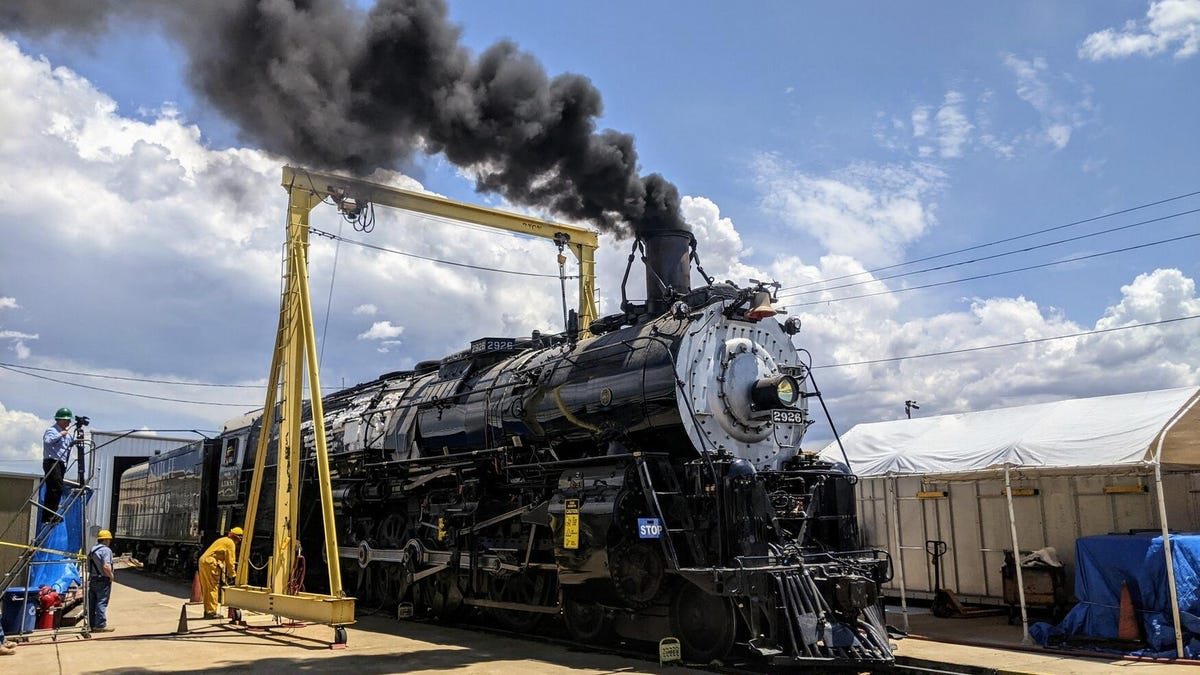Watch this giant steam locomotive train move itself for the first time in 65 years
The Santa Fe 2926 rolled down the tracks under its own steam power after an ambitious 20-year volunteer-run restoration.
Any big passenger or freight train engine is a marvel, a creature of metal, capable of pulling tremendous weight and traveling untired for miles. But there's something dreamy about a steam locomotive, a chuffing, huffing iron dragon from bygone days. Over the weekend, one of these fantastical beasts came back to life.
The Santa Fe 2926 was sitting in a park in Albuquerque in 1999 when the New Mexico Steam Locomotive & Railroad Historical Society bought it for a token $1 payment and began a restoration project lasting more than two decades. On Saturday, the mighty locomotive moved itself down the tracks under its own steam power for the first time in many long years.
The 2926 is one of the largest passenger engines ever built. It runs on oil instead of coal and was made by Baldwin Locomotive Works in 1944 for the Atchinson, Topeka & Santa Fe Railway. It once hauled freight and people across the American Southwest, running a million miles before its retirement.
"Under strict supervision by the Federal Railroad Administration and piloted by a professional railroad engineer and crew, AT&SF No. 2926 successfully rolled under her own steam power around 3:44 p.m. Saturday July 24, 2021, for the first time since the locomotive was taken out of service in 1953 and placed in a city park in 1956," the restoration group said in a statement.
Years ago as a volunteer for the society, I climbed down inside the boiler of the 2926. With plenty of headroom, I knocked rust off the inside with a scaler, a handheld power tool. I didn't spend much time on the project, but many other volunteers dedicated endless hours to pulling the engine apart, cleaning and rebuilding it, and breathing life into a machine that could have easily rusted away.
I stood in the New Mexico sun along with other society members on Saturday as we watched the brake tests and the steam build. After hours of final preparations, the 2926 slowly backed up, the monstrous wheels turning. With the clanging of its bell for a soundtrack, it then moved forward, a dream returning as reality to the rails.
The oil-carrying tender of the 2926 reflects the hard-hat-wearing members of the New Mexico Steam Locomotive & Railroad Historical Society gathered to watch the locomotive move under its own steam power.
As a longtime rail fan, I experienced all the signs of an elation high: the soaring heartbeat, the smile, the attention to every element of the scene around me. Steam rushed through the air. The whistle sounded in celebration. Volunteers cheered. Over 250 tons of history eased into motion.
Steam engines are curiosities, antiquated marvels in a modern day of diesel engines and electric trains. They embody a certain spirit of the past, a reminder that -- for good and ill -- we once harnessed our country to giants that ate coal, oil and water, and exhaled smoke and steam.
For now, the 2926 is a bit of a caged animal, restricted to 300 feet (91 meters) of track where the restoration crews have been working on it. The volunteers hope to see it set free one day, running the rails in the southwest, pulling passengers through scenic deserts and mountains... but that will require writing yet another new chapter in the train's history.
First things first. No longer a monument, the 2926 is a living legend.


